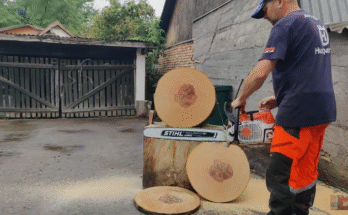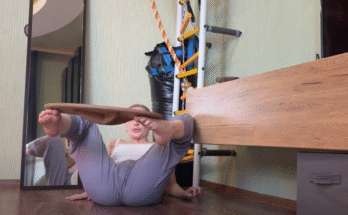
The first cold gust of wind hit me as I stepped out of the warm gas station convenience store, arms full of supplies—protein bars, instant coffee, and a couple of thermal blankets. The sun was already dipping behind the mountains, casting long shadows over the remote desert road. I slid into my Tesla Cybertruck, the metallic door hissing closed behind me, sealing me into a bubble of technology and quiet hums. I knew the night ahead wouldn’t be easy.
This wasn’t a trip I had planned. My original route was supposed to take me straight through Nevada and into Utah, with a motel reservation waiting for me near Zion National Park. But a sudden landslide had closed the highway, and my GPS rerouted me through a dusty, isolated backroad that stretched into miles of nothingness. The Cybertruck had been holding up great—its solar-charging panels were a lifesaver—but as the night fell and temperatures dropped, I realized I was going to have to sleep in it.

This would be my first time spending the night in the vehicle. Technically, the Cybertruck was built for it. With its 6.5-foot bed, foldable seats, and climate control system, it was more livable than many compact RVs. But I wasn’t just looking for comfort. I was in survival mode. Cell service was nonexistent. No houses, no towns. Just me, the desert, and my futuristic truck.
I backed the Cybertruck into a spot beside a cluster of rocks that offered a bit of a windbreak. Engaging the “Camper Mode” on the dashboard, I activated the climate system to maintain a steady 68°F, locked the doors, and lowered all the window shades. The cabin transformed into a quiet, insulated capsule.
I stretched out in the back with my sleeping bag unrolled and one of the thermal blankets wrapped around me. The Cybertruck’s tinted roof offered a clear view of the stars—millions of them, so bright it felt like I was drifting through space. The desert was eerily silent. Not a sound except the occasional whoosh of wind against the steel exterior.
But about an hour into the night, things started to get strange.
First came the sound—at first soft, then louder. A faint scratching. My heart jumped. I sat up and turned on the external cameras using the center console display. The infrared mode lit up the landscape in ghostly green tones. Nothing. I switched angles, scanned the back and both sides. Still nothing.

Then I saw it: a pair of glowing eyes, low to the ground, just outside the tailgate.
I froze.
It was a coyote, thin and wiry, its ribs visible under matted fur. It sniffed the back tire, then scratched at the tailgate like it was trying to climb inside. I watched as it sniffed, paced, and finally wandered off. My heart slowed again, but sleep didn’t come easy after that.
At around 2 a.m., the cold deepened. I noticed the temperature gauge on the display dip down to 25°F outside. Inside, the climate control worked fine, but I was using precious battery power. I debated shutting it off to conserve energy, but I didn’t know how long I’d be stuck. The sun wouldn’t rise until 6:30 a.m., and I had about 43% battery left. If I kept the heater on all night, I might lose another 10-15%. That still left me with enough to reach a nearby Supercharger, assuming the road opened by morning.
To take my mind off it, I played some soft ambient music through the truck’s surround sound system. The gentle sound of flowing water and forest birds seemed ironic out here in the dry, silent wilderness, but it gave me some comfort. I munched on a protein bar and made myself instant coffee with a small travel kettle plugged into the truck’s utility outlet. Sipping the warm liquid, I started to feel human again.

Around 4 a.m., the truck shook.
Not violently—just a small jolt, like someone had nudged it.
I sat upright instantly, eyes glued to the external camera feed. Nothing. Then another jolt.
I flicked on the external floodlights.
And there it was—a second coyote. Bigger this time, and not alone. Two more lingered behind it.
They must have smelled the food inside. The lights startled them, and they retreated into the shadows. I wasn’t in danger—they couldn’t get inside—but the realization that I was the only human within dozens of miles, surrounded by hungry animals and empty desert, sent a chill deeper than the night air ever could.
After that, I kept the lights on and the cameras running. The battery dipped to 30%. I knew I needed to be cautious, so I bundled up in my blankets and lowered the heat to 62°F. Uncomfortable, but manageable.
I must have dozed off sometime after 5 a.m. When I woke, the sky outside was beginning to lighten—faint purple and orange streaks on the horizon. I checked the Cybertruck’s system: 27% battery left, cabin temperature stable, and thankfully, no signs of further visitors.

I stepped outside into the crisp morning air. My boots crunched over the frozen sand, and I took a deep breath. The desert sunrise was breathtaking—vast, pink, and still. I turned to look at the Cybertruck, its steel frame frosted around the edges, yet resolute and unmoved. It had kept me safe through the night.
Within the hour, I drove cautiously back toward the main road. The GPS pinged with a signal, and I learned the detour road had reopened. I made it to the next Supercharger with 9% battery and a new respect for this strange vehicle that looked more like a spaceship than a truck.
Surviving overnight in a Cybertruck wasn’t luxurious. It was cold, a little eerie, and completely unforgettable. But it reminded me that with the right tools and mindset, even the most uncertain situations can be faced head-on. The wild is still wild—but I had steel, tech, and just enough grit to make it through.


